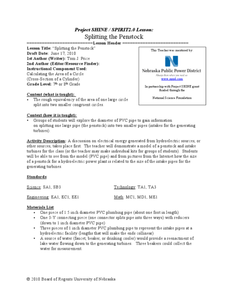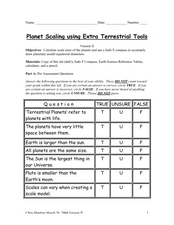Alabama Learning Exchange
How Big Can a Bee Be?
Mathematicians analyze the relationships between surface area and volume. They conduct Internet research, conduct various experiments, record the data in a spreadsheet, and graph the results and compare the rate of increase of surface...
Curated OER
Parachutes, Circles and Pi...Oh My!
Students explore different size circles to discover the relationship between diameter and circumference. In this circles and Pi instructional activity, students construct simple parachutes using circle patterns of varying sizes. Students...
Curated OER
Splitting the Penstock
Students investigate the best way to calculate the measurements of an area. In this geometry lesson, students relate a large circle to a cylinder and its measurements. They use PVC pipes to gain hands on experience as they calculate the...
Curated OER
Areas and Probabilities
In this area and probability worksheet, students solve 5 problems where they find the probability of an event occurring. They also use a given photograph of the moon's surface to find the area covered by craters and determine the...
New York Science Teacher
Planet Scaling using Extra Terrestrial Tools
Your class will use a set scale to convert diameters of planets to the model size, the diagram given to expand on the number of planets drawn as concentric circles, and examine the scale that would be needed to fit the larger...
Curated OER
Cross Sections and Collision Times
High schoolers solve five problems including finding the cross sectional area of two bodies, determining the swept out volume of a moving body, finding the average particle volume of a body and determining the collision time for a body.
Baylor College
There's Something in the Air
Clever! In order to compare indoor and outdoor dispersal rates for the movement of gases and particles through air, collaborators will participate in a classroom experiment. Set up a circular grid and set students on lines that are...
Curated OER
Circles in the Landscape: Irrigating Oklahoma Crops
How do you grow crops in a area with insufficient rainfall? Why you irrigate, of course. Class members investigate irrigation systems by designing a system of their own. After examining irrigation related concepts, vocabulary terms, and...
Concord Consortium
Line of Sight
There's no way around it—learners must use trigonometry to model the line of sight around a race track! Using the starting line as the origin, pupils model the straight line distance to any car using a trigonometric expression. The...
Curated OER
Building Bridges
Learners identify the different types of bridges. Using the internet, they research information on how they are built by completing a scavenger hunt. Locating a specific area, they determine which type of bridge would be appropriate and...
Curated OER
Geometry in Nature
Students examine how the circumference, diameter, and the relationship of Pi of a circle are related. They count the summer rings of a tree to determine its growth.
Curated OER
Counting Craters on the Hubble Space Telescope!
In this Hubble Space Telescope worksheet, students are given a photograph of the radiator recovered after being in space on the Hubble Space Telescope since 1993. Students solve 6 problems about the impacts that left craters on the...
Curated OER
Spitzer Sees a New Ring Around Saturn
In this Saturn's rings worksheet, students read about the Spitzer telescope that detected a new ring around Saturn. Students solve 6 problems including determining the formula for the area of a circle, finding the volume of the new ring...
Curated OER
Getting an Angle on the Sun and Moon
In this Sun and Moon worksheet, students solve 6 problems about the angular scale of the images given, the size of the features on the images and the area of the features shown.
Curated OER
Kepler-The Hunt for Earth-like Planets
In this hunt for planets worksheet, students read about the Kepler satellite used to detect exoplanets. Students solve 6 problems including drawing a sun disk and determining the scale in kilometers/millimeter, finding the area of the...
Curated OER
Creating a Basal Area Measuring Tape
Students use formulas to design and create a table. In this calculations lesson students create basal measuring tapes that will be used to measure woodlot stocking levels.
Curated OER
Amazing Transpiration
Learners observe a leaf and discuss the way that water is released from a leaf through its stomata. For this water cycle lesson, young scholars calculate how much water leaves produce from a whole tree.
Curated OER
Round and Round--Wheels and Axles
In this wheels and axles worksheet, learners read a 1 page article, make a list of how many objects they can find or think if that uses a wheel or axle and then design their own machine.
Teach Engineering
The Great Gravity Escape
Groups simulate an orbit using a piece of string and a water balloon. Individuals spin in a circular path and calculate the balloon's velocity when the clothes pin can no longer hold onto the balloon.
Curated OER
Will There be Enough Water?
Students investigate water usage, water available, and water demand historically in the local area. They use projections of water usage, availability and demand up to the year 2050. Students use graphs to relate as well as compare and...
Curated OER
Bubble Map
This PowerPoint provides a brightly colored "bubble map" featuring one large center circle and a smaller colored circle in each corner. This is an attractive generic graphic organizer that could be used in any content area.
Curated OER
The Prairie Climate
Ninth graders research the average temperature and precipitation of a prairie region to determine the type of climate it is, and how it differs from other biomes. They examine the types of adaptions animals have made to live in the...
Teach Engineering
Ampere's Law
Help your class find the the magnetic field of a toroid, a solenoid bent into a circle with an activity that allows the class to see how a loop of wire carrying an electrical charge behaves much like a magnet. The resource provides...
Curated OER
How Big is a Molecule?
Students estimate the size of a molecule of oleic acid. They conduct an experiment using chalk dust, water, and oleic acid, solve various calculations, and answer discussion questions.























